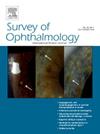Choroidal nevi and melanoma doubling times and implications for delays in treatment: A systematic review and meta-analysis
IF 5.1
2区 医学
Q1 OPHTHALMOLOGY
引用次数: 0
Abstract
The prognostic implications of delaying treatment for primary uveal melanoma remain debated. We evaluate the impact of choroidal nevi and melanoma doubling times on metastatic death incidence and compare this impact across different tumor sizes. A literature search in PubMed and Web of Science targeted studies published after 1980 that quantified growth rates for choroidal or ciliochoroidal melanomas or nevi based on serial imaging found 199 melanomas and 87 growing nevi from 5 studies. In a random effects model, the estimated average volume doubling time was 360 days across all patients, with doubling times of 717, 421, and 307 days for small, medium, and large melanomas, respectively, and 6392 days for growing nevi. A mixed-effects model estimated that the 10-year incidence of metastatic death increases by 0.3, 1.8, and 4.0 percentage points every month a small, medium, and large melanoma remains untreated. Similar results were produced using two independent sources for survival data. These findings suggest that choroidal melanoma growth follows a super-exponential curve, with larger tumors exhibiting shorter doubling times. Based on these growth rates, delaying definitive treatment increases the risk of metastatic death by nearly zero to several percentage points per month, depending on tumor size.
脉络膜痣和黑色素瘤的倍增时间及其对延迟治疗的影响:系统回顾和荟萃分析。
关于原发性葡萄膜黑色素瘤延迟治疗对预后的影响仍存在争议。我们评估了脉络膜痣和黑色素瘤倍增时间对转移性死亡发生率的影响,并比较了不同肿瘤大小对这种影响的影响。我们在PubMed和Web of Science上搜索了1980年后发表的基于序列成像量化脉络膜或纤网膜黑色素瘤或痣生长率的研究,其中包括5项研究中的199个黑色素瘤和87个生长痣。在随机效应模型中,所有患者的平均体积倍增时间估计为360天,小型、中型和大型黑色素瘤的倍增时间分别为717天、421天和307天,生长痣的倍增时间为6392天。根据混合效应模型估算,小型、中型和大型黑色素瘤每未经治疗一个月,10 年的转移性死亡发生率就会分别增加 0.3、1.8 和 4.0 个百分点。使用两个独立的生存数据来源也得出了类似的结果。这些研究结果表明,脉络膜黑色素瘤的生长遵循超指数曲线,大肿瘤的倍增时间更短。根据这些生长速度,推迟确定性治疗会增加转移性死亡的风险,每月增加的风险几乎为零到几个百分点不等,具体取决于肿瘤的大小。
本文章由计算机程序翻译,如有差异,请以英文原文为准。
求助全文
约1分钟内获得全文
求助全文
来源期刊

Survey of ophthalmology
医学-眼科学
CiteScore
10.30
自引率
2.00%
发文量
138
审稿时长
14.8 weeks
期刊介绍:
Survey of Ophthalmology is a clinically oriented review journal designed to keep ophthalmologists up to date. Comprehensive major review articles, written by experts and stringently refereed, integrate the literature on subjects selected for their clinical importance. Survey also includes feature articles, section reviews, book reviews, and abstracts.
 求助内容:
求助内容: 应助结果提醒方式:
应助结果提醒方式:


